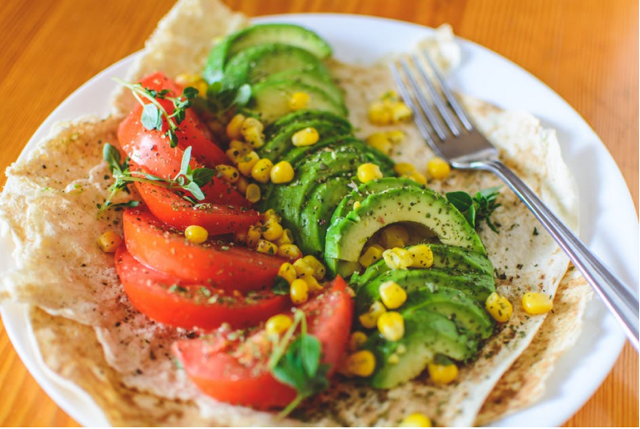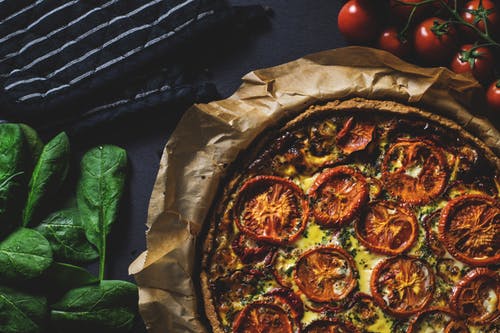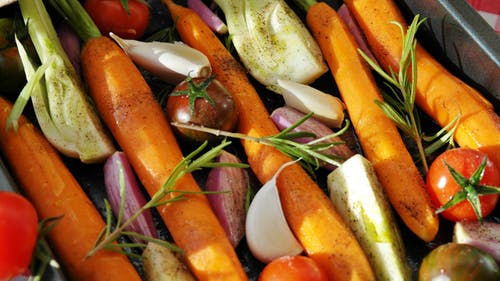What's for dinner? Meatless meals, family style
Going meatless tonight? Replacing “meat and potatoes” with a healthy alternative - like this veggie taco - gets easier with time, practice, and a handful of reliably good recipes.
I grew up in the Midwest, Land of Meat and Potatoes, in a family where vegetables were found in cans or freezer bags from fall through spring, and were sometimes forgotten altogether. Vegetables were a side dish, not a main dish, and vegetarianism was a largely foreign concept.
“When we’d ask, “What are we having for dinner?” the answer might be hamburgers, hot dogs, fish, chicken, brisket...in other words, meat. ”
When we'd ask, "What are we having for dinner?" the answer might be hamburgers, hot dogs, fish, chicken, brisket...in other words, meat. Pasta and potato dishes were also prepared with an animal product like beef or chicken, as were soups and stews. Meat, after all, was what gave food flavor, or so my Eastern European family believed.
While I've come a long way from the "square meal" ideal of my childhood, preparing dinners without a meat entree can still be a challenge. After all, it's so much easier to grill or bake a piece of chicken or fish, add veggies, some pasta or rice, and voila—you have a meal.
Elisse Gabriel’s family (pictured here, with friends) barely notices there’s rarely meat at the table. She says the reason is simple: the alternatives taste really good.
My older son Noah, now 21, has been a vegetarian since second grade, and I, too, eat mostly vegetarian meals (with the occasional exception of fish), so I've had years to experiment with meatless meals. Granted, my husband and younger son Aidan still eat meat on the rare occasions I serve it, so I've had to make whatever I cook appealing, tasty, and satisfying for all.
One step meal? Fill a fresh corn tortilla with just about anything - fresh vegetables, brown rice, cheese, salsa, as in this recipe. Done. Photo: Anthony Scrivani
Since I didn't often have the time to cook elaborate dinners while raising my sons, I learned how to whip up entrees that were simple but nutritious and ample enough to satisfy two growing boys. After the meals were inhaled, we’d sit, chat, and talk about our day, which might include a discourse on Berkeley High slang (it’s a real thing), gross boy humor (inevitable with three males at the table), or “three good things of the day,” a practice Aidan learned from UC Berkeley’s Greater Good Science Center.
Most of what I prepare is fairly simple and varies according to what is available seasonally and locally. Some meals were major winners, make-your-own-sushi night, for example. Others were met with less enthusiasm. (No thank you, lentil stew.) Over the years I gradually stopped relying on recipes, though I’ve included a few here to make it easy to get started. Here, then, are my suggestions for moving meat off your plate, without anyone noticing.
Make-Your-Own Shmorgasbord
Elisse’s husband, David, samples a carrot on sushi night.
A family favorite is "make-your-own" nights, including make-your-own sushi and tacos. These meals are simple, fun, and get everyone involved. For make-your-own sushi, all you need is steamed rice (ideally Japanese sticky rice), sheets of seaweed, and your favorite fillings (like sliced carrot, avocado, cucumber, tofu, and omelet). Even if you're not experienced at traditional wrapping methods, it's easy enough to spoon some rice on the seaweed, add toppings, and create a hand roll.
For make-your-own taco nights, we typically heat up some vegetarian refried beans, corn tortillas, shredded cheese, lettuce, avocado, steamed rice and salsa, then let everyone help themselves.
Add a salad and - presto! - you have dinner
I typically include a green salad with most meals, mostly because the greens help fill us up, plus I just really enjoy preparing and eating them. I often toss in some vegetarian protein like toasted nuts or pumpkin seeds, and canned beans (like butter beans, cannellini or black beans), along with favorite fixings like carrots, red peppers, cucumbers, and avocado.
Adding a salad loaded with veggies is an easy and healthy way to fill out a meal.
Don't be afraid to throw in fruits like diced fresh apples or dried fruit (like tart dried cherries or cranberries). They add a nice sweetness and texture and naturally complement most vegetables. To make the salad heartier, top it with a veggie burger, hard-boiled egg, roasted veggies, or falafel balls. Cooked wheat berries add a nice al dente bite, especially tossed with kale, Parmesan and vegetarian Caesar dressing.
Throw broccoli, garlic, whatever on Pasta
Pasta is a decent source of protein. Add veggies and you have a filling - and delicious - meal. Try this Rigatoni with Broccoli Pesto.
My kids' favorites include some obvious choices, like homemade macaroni and cheese and vegetarian lasagna. A quicker variation on the theme is fresh pasta tossed with your favorite sauce, like pesto, tomato, or fresh garlic and olive oil, along with sautéed vegetables, like mushrooms, broccoli, red peppers and zucchini and even vegetarian meatballs. Add a green salad, and a warm baguette or garlic bread and you’ve got a complete meal. (Note: Watch how quickly everyone comes to the table when the smell of warm garlic bread is wafting from the kitchen.)
Pizza is healthier when you make your own
Top whole wheat pizza dough with roasted vegetables for a healthier quick meal.
Pizza is often a go-to meal, especially when kids and lack of time are involved, but there are ways to make this doughy option far healthier and just as fast. Trader Joe's now sells prepared whole wheat dough, as well as cornmeal and even cauliflower crusts. Quick-cooking polenta makes a delicious base, too. Top it with roasted or sautéed vegetables, pesto or tomato sauce and cheese, and even add some fried or scrambled eggs for extra protein.
memorize a few good soup recipes
This lentil recipe, with its blend of buttery red lentils, fresh lemon, and cilantro, is a winner. Photo: Joseph De Lio.
Soup is another great option. It’s surprisingly fast and easy to prepare. In the Bay Area, it’s often cold, so soup is both warming and filling. Plus, it’s fun to experiment with flavors and ingredients and see how they come together. In a hurry? Add chopped veggies and tofu cubes to miso or vegetable broth. Simmer, then add ramen noodles or vegetarian pot stickers. You'll have dinner in a bowl in record time.
Want to get people to love veggies? Roast them
Even people who aren’t fans can be won over by vegetables that have been roasted.
Whether you serve them as a side or main dish, roasted vegetables are a crowd pleaser. Yukon Gold potatoes, sweet potatoes, brussel sprouts, broccoli, cauliflower, kale, and carrots all roast beautifully. Pair with black beans and quinoa, and you have a colorful, nutritious meal.
To roast, cut up veggies, toss in a bowl with olive oil, salt, and garlic powder, and bake at 400° F until browned, then flip until evenly cooked. The vegetables get a crisp, caramelized finish that brings out their natural sweetness. A sprinkle of nutritional yeast on top adds a nutty flavor, protein, and B vitamins.
Breakfast for Dinner
At the author’s house, scrambled eggs are as likely to show up for dinner as breakfast. Photo: William Sonoma
My personal favorite? Breakfast for dinner. It’s quick, tasty, and always comforting. Plus, it rekindles warm memories of Sunday brunches growing up with my big, boisterous family. High protein options can include scrambled eggs or omelets, scrambled tofu, vegetarian sausage and hash browns or roasted sliced potatoes made with Yukon Gold or sweet potatoes.
Elisse Gabriel is a writer, editor, and the author of The Emerald Matchbook, with a range of clients in the health & wellness and culinary industries. She lives in the Bay Area.


















